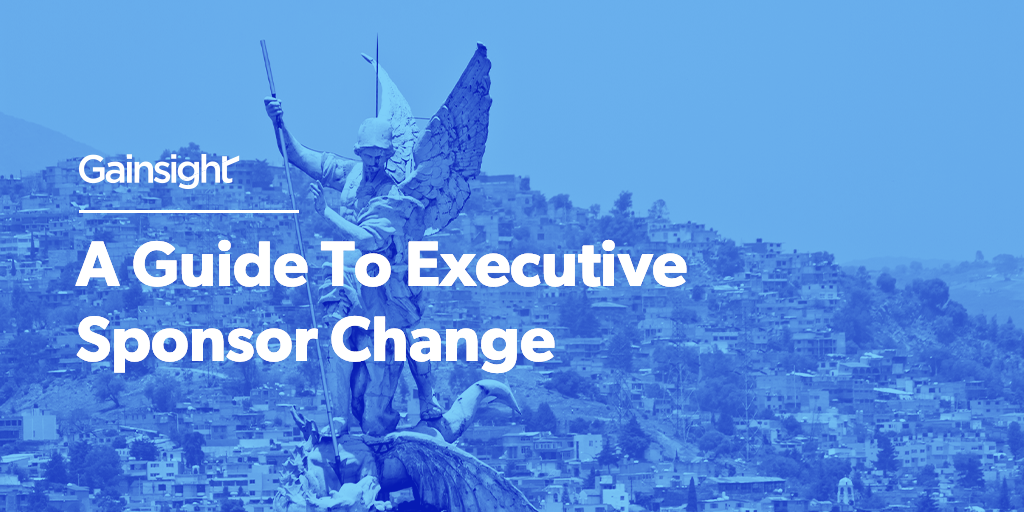This is a blog about how to create a strategy for dealing with sponsor change. But because it’s me, I want to first talk a bit about quantum mechanics and causal determinism. Feel free to skip down for the business tactics, but if you’re interested, read on!
Data, determinism, and demons
In his 1814 Philosophical Essay on Probabilities, the physicist Pierre-Simon de Laplace imagined a hypothetical intellect that could “know all forces that set nature in motion, and all positions of all items of which nature is composed” and in so knowing, extrapolate the entire history and future of universe. This intellect was dubbed “Laplace’s Demon.”
In other words, according to Laplace, a perfect prediction of all future events and behaviors was simply a matter of information. Everything is “determined,” therefore if you have enough information, or in this case, all the information, you have a perfect picture of the universe—past, present, and future.
In the age of big data, machine learning, and business intelligence, we have a very determinist view of our customers. How many times have you heard in response to something happening you didn’t predict, “Well, we just didn’t have the right data,” or “The data is the problem!” Or conversely, that if you can just get more and better data, you can “solve” your customers like you would solve a complicated algorithm.
And that is true to an extent—at Gainsight, we have a huge investment in identifying more accurate ways to collect data from as many sources as possible, synthesize it, and derive meaningful insights from it that can help us forecast future customer behavior. (Not-so-humblebrag: we’ve gotten really, really good at it!)
But no matter how sophisticated we get, there’s one thing every B2B company deals with that will almost always be an issue for the Theory of Customer Determinism: sponsor change.
Customer Chaos Theory
Sponsor change is what happens when the person most directly responsible for the purchase and ownership of your product leaves their business for another job. When it happens (and it will happen to most of your customers eventually), it’s more likely to hurt your relationship than help it—in fact, it’s most likely to end your relationship.
And you can’t predict it. You can only react.
At the risk of massively oversimplifying Newton’s Second Law of Thermodynamics, it basically states that the entropy (or randomness) inside a system will increase over time. Another way to think about randomness is as a lack of information. What I mean by that is if Laplace’s Demon truly did know the nature and state and position and energy etc. of ALL the particles in the universe at a given moment, it couldn’t extrapolate their future states perfectly as entropy (randomness) increased in the system over time.
I won’t get too deep in the weeds on quantum indeterminacy here. But Laplace’s Demon existed long before quantum theory did. To make a complex topic WAY too simple, subatomic particles don’t necessarily have determinate information for their states—it’s not that they’re just unknown, it’s that the information doesn’t exist: true randomness.
Entropy—as it does in the universe—will increase in your customer relationships over time. The natural tendency of every customer is to churn. You can be incredibly sophisticated in predicting and guiding your customers through renewal and expansion, but randomness is always lurking.
Six tactics to react to executive sponsor change
If you skipped the physics stuff, welcome back! Because of the “random” nature of sponsor change, it’s the most difficult customer risk to prepare for and it’s the one I see so many organizations struggle with.
I hope to change that in this post with these six practical tips.
1. Identify contacts
The first step in building a sponsor change playbook is understanding who the people are in your customer and how they relate to your company and to each other. A lot of companies only have operations for understanding their customers on the Account-level. People are dealt with on a more ad hoc basis. But the best operational practice is to have systems for mapping and tracking interactions with people too.
In Gainsight, that’s called a Person object. With this object, we can log information (contact info, LinkedIn page, company, manager, etc.) and—crucially—their role in the relationship as a sponsor or champion or as an influencer of buying decisions and more.
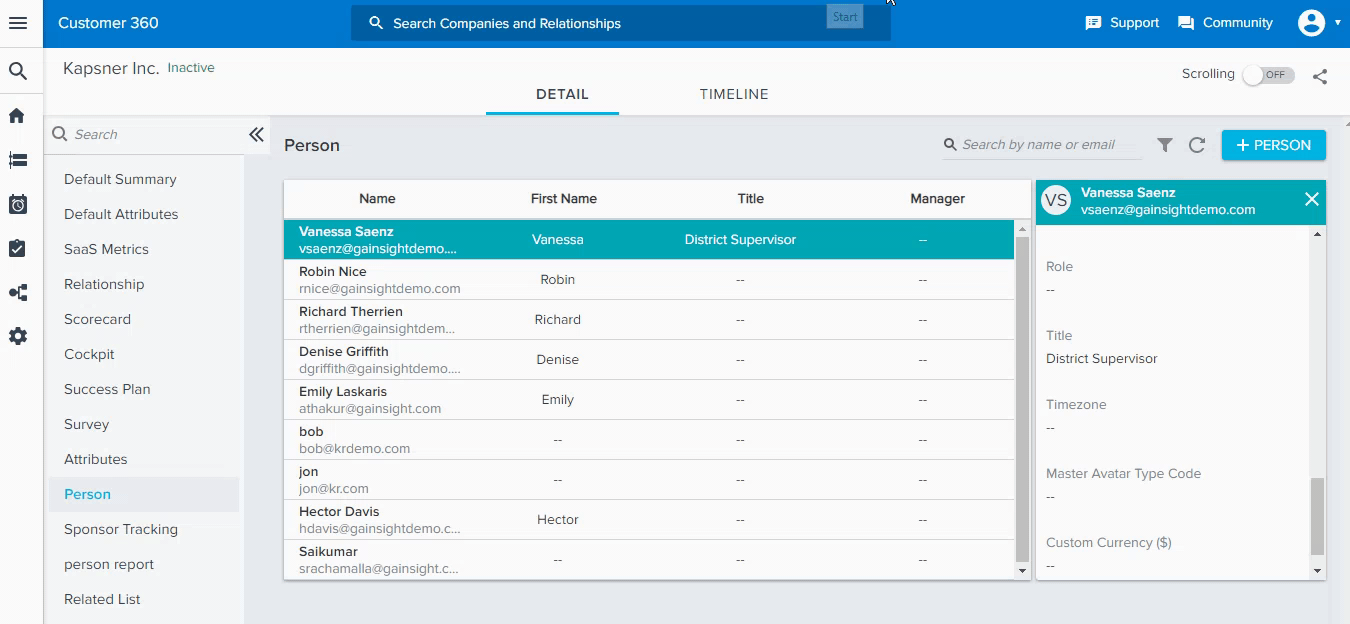
This sounds pretty basic and fundamental, but I’m not surprised anymore how few B2B companies don’t have a process for understanding and logging this incredibly important information. Ask yourself, if your key sponsor at a customer quit their job, how and where would you log that it had even happened?
Tip: Before you can respond to sponsor change, you need an ops process to map your customers at a Person-level.
2. Monitor contact change
If you’ve been through a sponsor change situation, you know you’re never the first person to know. When someone gets promoted or fired or quits, it’s not likely their CSM is the first person on speed-dial. Chances are you find out in your next scheduled meeting or their IT team replies to one of your emails with a “sorry, that person no longer works here” message. That’s what’s so challenging, because in sponsor change scenarios, responding quickly is so important.
Gainsight has a sponsor tracking feature that syncs with your champion’s LinkedIn profile and notifies you if their job title or company changes. It’s the most proactive way we’ve found to keep tabs on a sponsor change event—which we consider a high-risk, high-priority code red event.
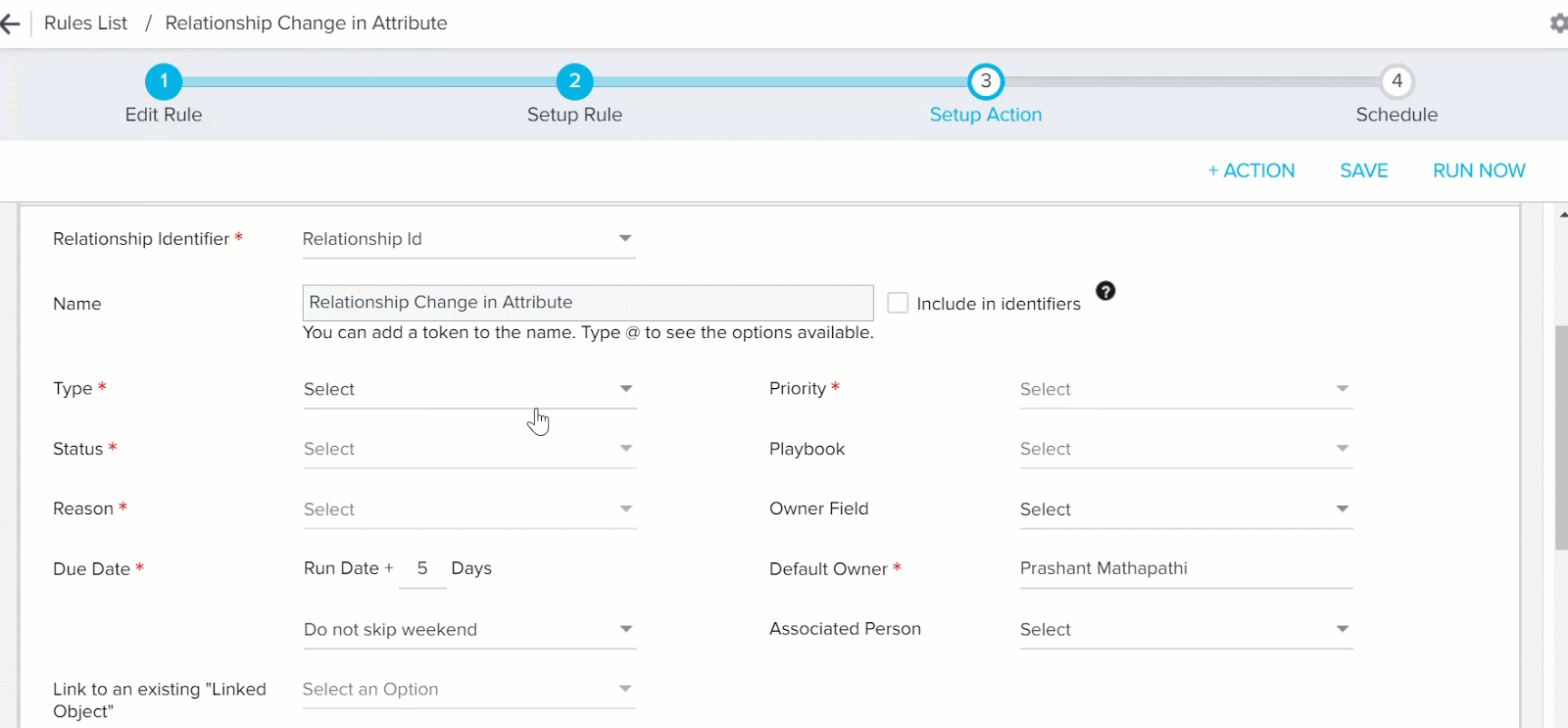
Now, obviously not everyone uses LinkedIn or updates their job information immediately. You’ll still need to track sponsor change with a manual call-to-action (CTA) when you find out about it through other channels. The CTA triggers the response playbook which I’ll talk more about below.
The standard operating procedure for most companies is panic, have a meeting, respond on a case-by-case basis. But that’s not scalable and not effective.
Tip: Have a method for identifying sponsor change as quickly as possible, and a standardized playbook that triggers as close to automatically as you can make it.
3. Understand the “lay of the land”
One mistake too many CSMs make that will lead to challenges in not only in sponsor change situations but in other “moments of truth” in the lifecycle of the customer is having a very narrow focus on a few high-level contacts. It’s important to foster communication with a broad spectrum of users and stakeholders no matter how low they are on the org chart. This will help you get insight into the bigger picture of the company, the trajectory of the organization, and sometimes even risks you wouldn’t have otherwise seen coming. We operationalize this in Gainsight using a really cool feature called People Maps.
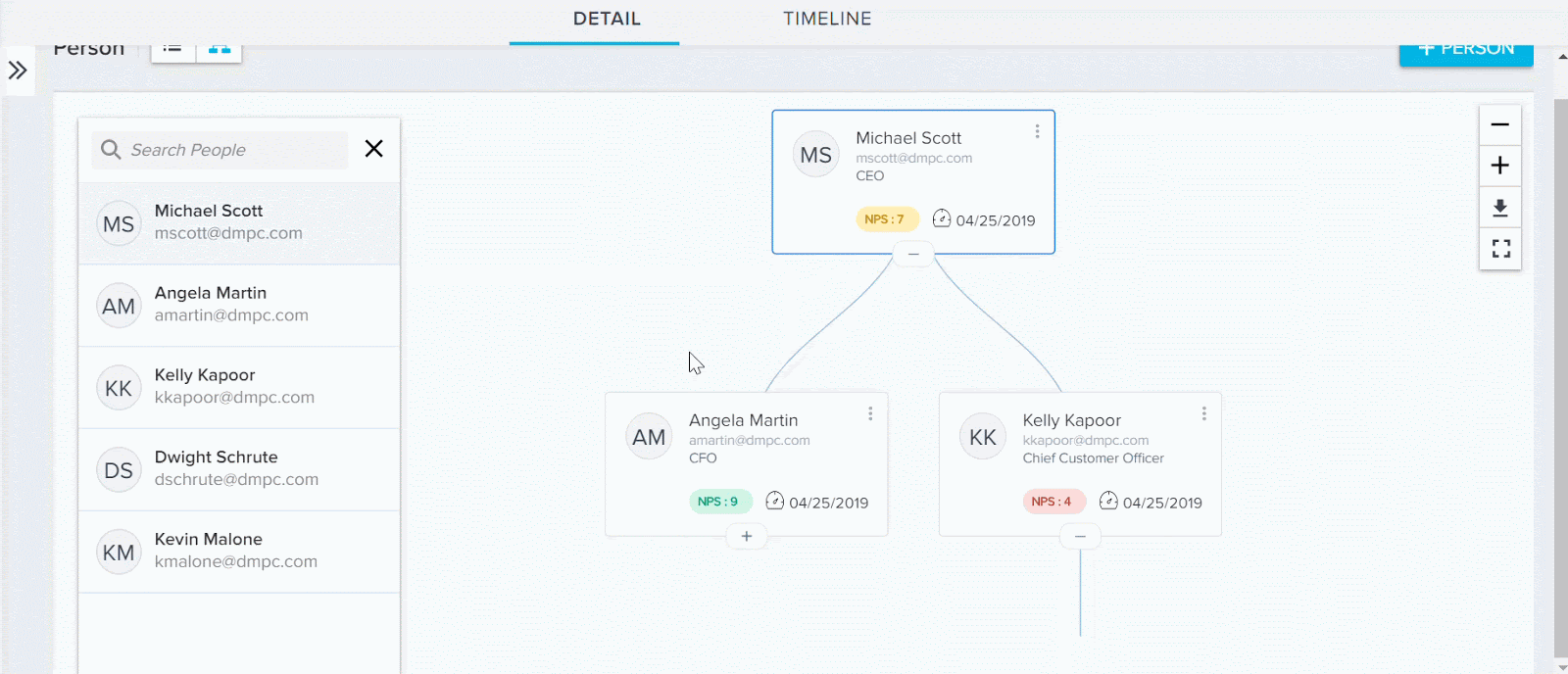
Once you have the “lay of the land,” you also need a framework to respond to sponsor change. That means building out a playbook. Here’s an example of a workable playbook that can help you get started building one that works for you:
- CSM notifies your team’s executive sponsor of the change.
- CSM contacts customer, verifies change, and gets introduction to new Business Owner.
- CSM updates CRM with new contact and role.
- Executive Sponsor makes connection with new customer Business Owner.
- CSM schedules the next Executive Business Review (EBR) with the new Business Owner.
- CSM creates new a rule using Sponsor Tracking to track where previous Business Owner lands and notify Sales when that happens.
- CSM reaffirms ROI and goals with new Business Owner and with customer Executive Sponsor in the next EBR.
We’ll get into some best practices for a few of those items below. Keep in mind that depending on your business model or customer, you may have a more hands-on or hands-off process.
Tip: Codify your sponsor change playbook and automate it as much as possible.
4. Reach out to your ex-sponsor in their new role
At Gainsight, we’ve had a lot of success in re-selling to our executive sponsors as they move between companies. Part of this is proactive—we maintain deep connections to a ton of excellent customer success leaders and we help them get placed with companies in our network. It’s great for people advancing their careers, it’s great for companies trying to find qualified leaders who “get it,” and it’s great for us because it helps us get in the door at new companies.
So we always reach out to sponsors when they move companies—especially when it’s unexpected. There are three main reasons why you want to do this:
- Learn about why they left. Was it a failure to meet their goals? Changing needs/priorities at the company? Just a change of pace, nothing to see here? You need to know whether your product or service played a role—however big or small—in the decision, and what you can do to preserve the relationship going forward.
- Get critical intel for your team. Your next meeting with your client is going to be a big one. Any and all knowledge you can get about the situation on the ground is potentially gamechanging. Who are the new stakeholders going forward? What are their priorities? How do they view the relationship with your company?
- Get a new lead for your Sales team. Your sponsor already is familiar with your product and if you helped them achieve their desired outcome, they’re a fantastic lead for a new booking at their new company. Are they in a similar role? Is their new company using your competitor? Try and get the info your Sales team needs to help guide their conversations.
Tip: Stay in touch with your executive sponsors as they change companies throughout their career. Consider creating a database of past and current sponsors your company can recommend if approached for hiring recommendations.
5. Have a manager or exec reach out to the new exec at your client
Like I said, your next meeting with the customer is going to be one of those “moments of truth” I talked about. But equally important is your “first contact” with the new executive sponsor. I’ve found this is best done by one of your company’s own executives or managers to signal the importance of the relationship. Keep in mind, this person is new on the job, and they are likely extremely busy at this particular moment. Your pitch should be very tight and very short. Stay focused on what you can offer them, not the other way around. And there’s a lot you can offer!
- Intel into their new role, the challenges their predecessor faced, and any wins they achieved with your product.
- Any benchmarking data you’ve tracked from the customer. What’s been the value your product has driven over the course of the relationship?
- Any direct and actionable advice you have for the next 30, 60, and 90 days. Quick wins they can get, efficiencies they can use to streamline this transitionary period, and even longer-term strategies they can pitch to their leadership.
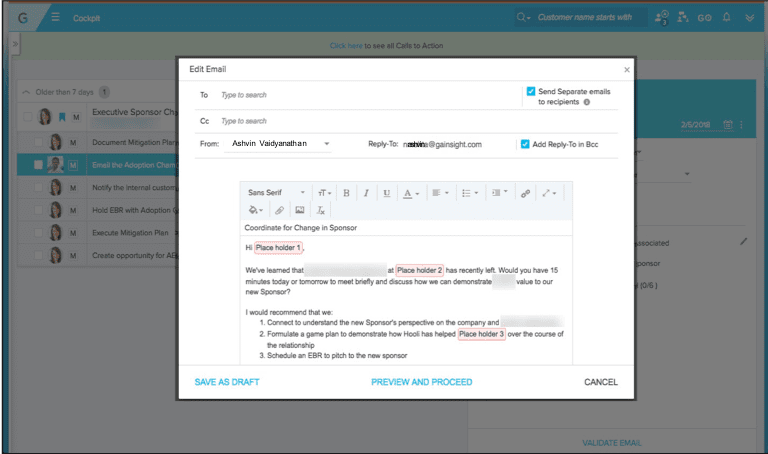
Definitely think about sending over a gift-basket. This is a business conversation, but business is personal! Try making a personal connection. Find out what if there’s something they might like that you could send to them.
Tip: Customer success is all about helping your customers achieve their desired outcomes with your product—even if the people at the company change. This is a high leverage moment to demonstrate your company’s value at your customer. It’s worth everyone’s time—especially execs’ time.
6. Establish a regular cadence with the new sponsor
Last step: it’s time to get on a regularly scheduled communication cadence with your new sponsor. Typically, it will be a similar cadence to your previous sponsor, but you shouldn’t take that as a given. At Gainsight, we have 14 Elements of customer success, and one of them is called Stakeholder Alignment. The Elements are simply prescriptive best practices we’ve learned based on over 500 successful customer success implementations.
There are six steps for operationalizing this process:
- Map out the key personas at your customers that include sponsors/buyers, influencers, administrators/power users, and adoption champions.
- Identify the sponsor or “buddy” from your company that maps one-to-one to these key personas.
- Operationalize a regular cadence of outreaches from the buddy to the key personas.
- Set up alerts when a sponsor leaves the company and a playbook to mitigate the risk.
- Document notes from these outreaches for future reference.
- Track these outreaches as a health score measure that shows progress over time.
Let’s drill down on two and three here.
We have a “buddy” system where we match similar personas from our company and our customer’s. For us, Chief Customer Officers at mid-touch customers are matched to our VP of Customer Success. I’m personally mapped to CEO and CCO-level buddies at our largest enterprise customers. At mid-market and SMB customers, you’ll probably choose to have managers or directors on your team be assigned as buddies to their sponsors for better scale.
Then we set up a regular cadence, not too often, where buddies reach out to their counterparts. We’re talking about one monthly email and one quarterly scheduled call in most situations. This is all aided by automation in Gainsight to keep us on track and make it all scalable.

Tip: Having dialogue with your customers is the absolute MOST valuable thing your company and your teammates can do. Put together an operational process to make your customer communications as frictionless for both you and your customer.
Embracing chaos during internal champion loss
Sponsor change is a major hangup for any company. It introduces so much unpredictability into your business.
In a deterministic world, your customers would be perfectly predictable with enough data. But personally speaking, determinism always seemed super depressing. There’s no free will when all your actions are predetermined. There’s an idea in information theory that suggests that the “random” is any information that can’t be compressed beyond its current state. That the universe can’t be reduced to a perfect equation because of these random, uncompressable quantum data. And that maybe that’s where our free will comes from.
I like that idea! But beyond the abstract philosophizing, the random parts of interpersonal relationships are the most engaging as well. Sponsor change is clearly a delicate time for any vendor, but it’s also a huge opportunity—to grow your relationship with the new sponsor, to follow the previous one to their new company, and to improve your processes as well.
If you want more help with sponsor change, Gainsight has a ton of functionality designed to solve this challenge. You should think about getting a demo if you haven’t already!
